D
Dave Coster
Guest
RIG SCISSORS
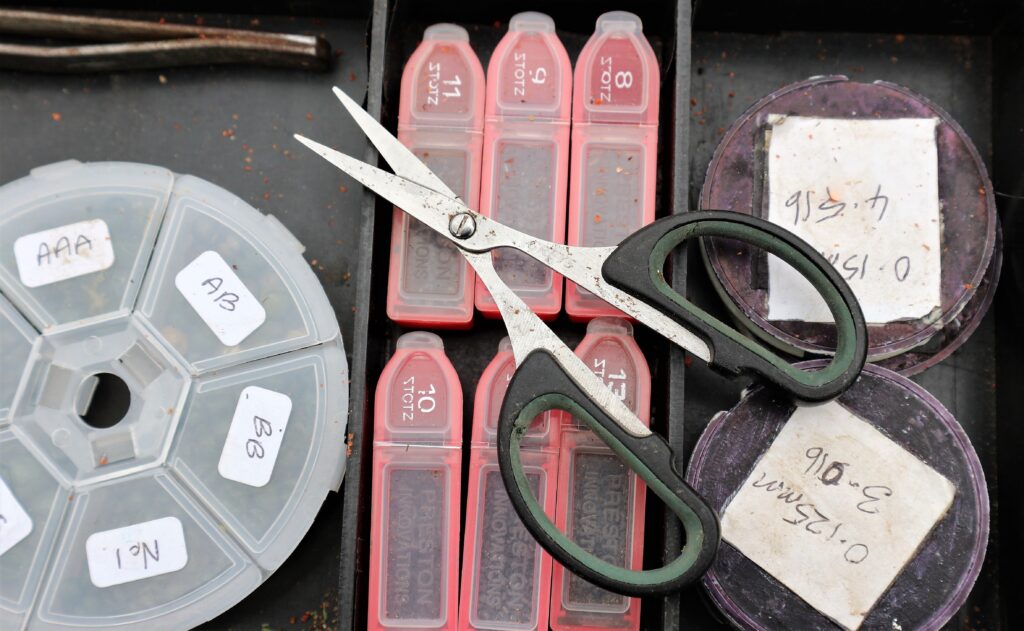
Certain tools make life easier while fishing, even to the extent of improving your results. A decent pair of rig scissors being a good example. With hook knots in particular, I suspect fish can feel long tag ends when they are mouthing baits, which is likely to make them suspicious and potentially reject them. A simple pair of stainless-steel rig scissors, with pointed blades, saves your teeth and trims knots more precisely. Finely tapered tips trim neater than round-nosed ones, which are harder to butt up close to knots. Scissors suitable for storing in a tackle box are best if they are on the compact side, making sure they have slightly elongated handles. I avoid small scissors with round grips, which don’t tend to suit angler’s fingers very well. It’s also good to have handles covered with non-slip rubber grips, making delicate operations with wet hands go more smoothly. Apart from trimming line, I use rig scissors for snipping various hook baits.
STYL PINCERS
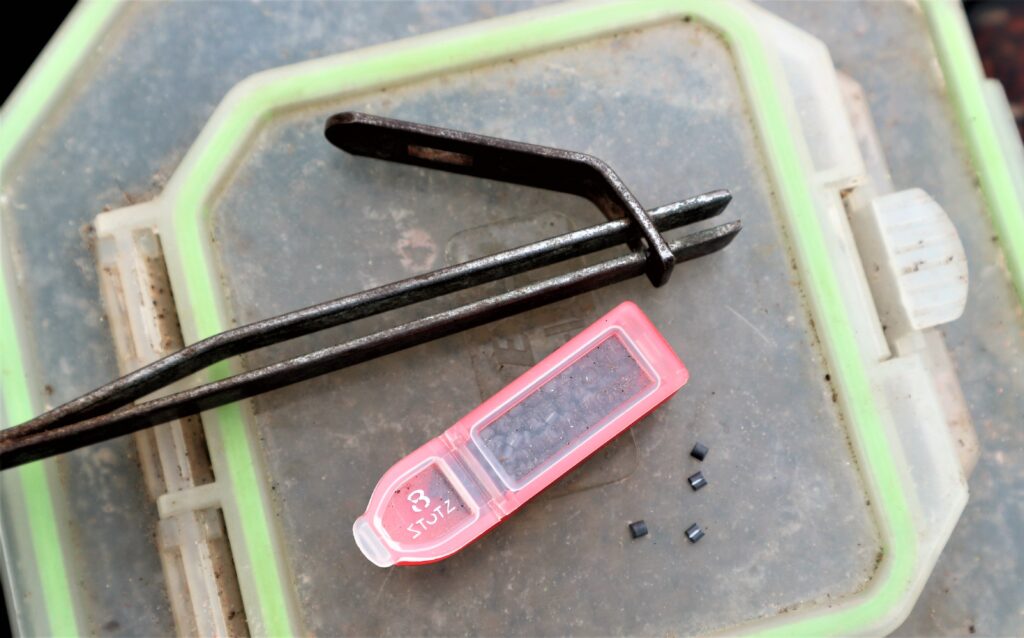
I’ve had these pincers in my fishing kit for several decades. I still see similar designs in tackle shops to this day. I originally used them with Continental Styl weights, but they are now employed for applying the shorter Preston Stotz version to line. Stotz replicate micro shot sizes from 8s to 13s, but instead of being round are elongated, making them easier to nip onto fine lines. Due to this, I hardly ever use small round shot anymore. I know there’s a special tool for Stotz weights, but I find it too blunt-nosed and awkward to operate. Styl pincers have much finer jaws, allowing tiny weights to be picked up from a flat surface in a speedier manner. They have a better feel factor too, so I can gauge just the right amount of pressure to apply. I also use them to flatten barbs on small hooks, a job they do perfectly. I still have a Stotz tool, called a Stotta, using its special cutting tooth to remove excess weights from mono, a task it is very good at performing.
NEEDLE & DRILL
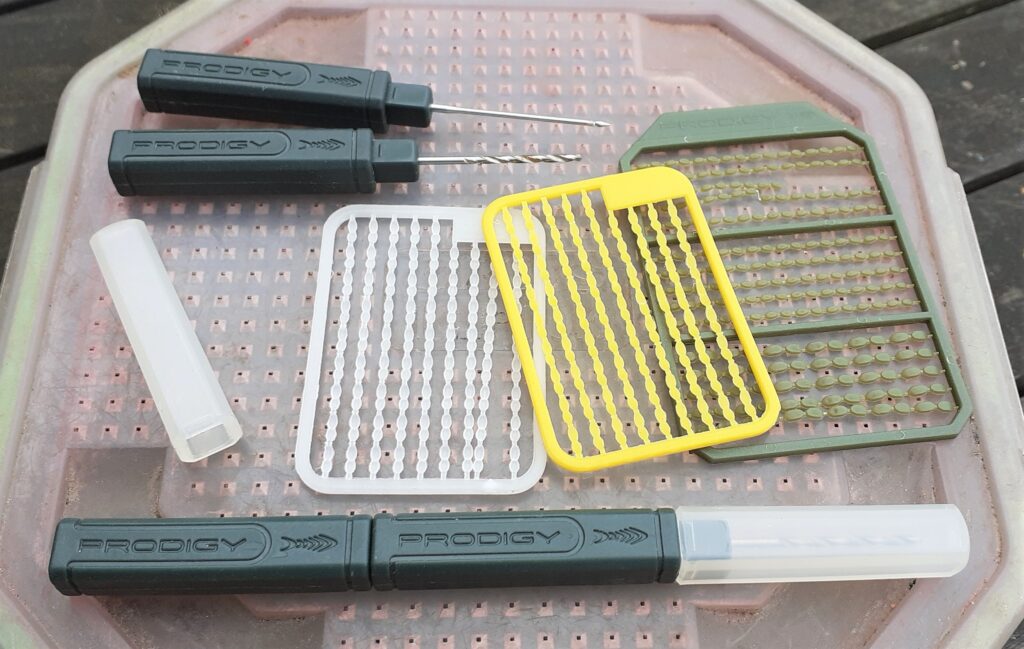
When I used to work in a big tackle shop I got fed up with trying to find matching hair needles and drills, which customers were always asking for. Lots of companies produced these products, but it was never easy to get the right match. Typically, I think it was Drennan who brought out the first proper combo, so you knew the needle would go through holes in any hard baits that the slightly bigger drill had made. When I was product development manager for Greys, I took this a step further, designing a hair needle and drill set that clamped together, a bit like a pen, along with a protective cap. Because tools like these are on the small side, it can be tricky to get enough grip to drill hard items, so the idea was to push the two units together for jobs like that. I made the handles square, so they wouldn’t roll off tackle box lids, or bait trays and tables. I always had an agenda of striving to produce tackle accessories that made a difference.
PELLET BANDER
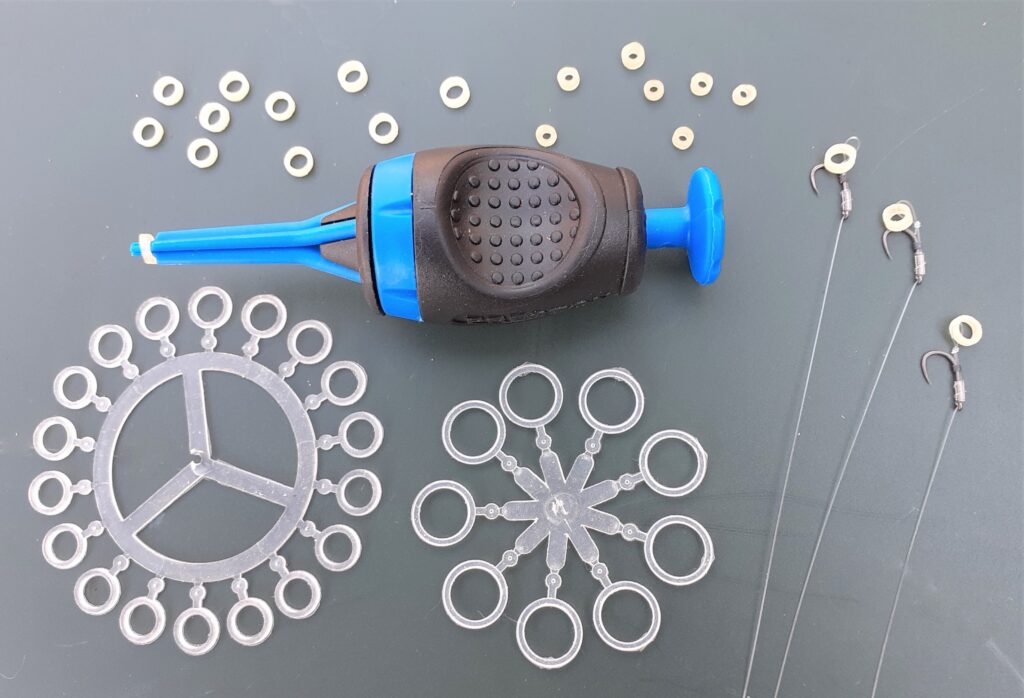
Every now and then something comes along that makes a big change to the way we fish. I suspect pellet bander tools might have originally been designed for a different usage, but fair play to whoever discovered them and applied the concept to banding pellets. These tools make life so much easier when using tiny latex bait bands, especially the type ready-installed in looped hairs. Even mini sizes can quickly be stretched over hard pellets up to 8mm, along with small buoyant wafters, only taking a few seconds to do the job. This results in nicely presented hard baits, much faster than fussing about with drills, needles and fiddly bait stops. Pellet banders have inspired anglers into experimenting, to the extent some now even band natural baits like maggots and casters in the quest for superior presentation. A few of my mates are dextrous enough with their fingers to get by without these tools, but I often sneakily use them to keep up.
MULTI TOOL
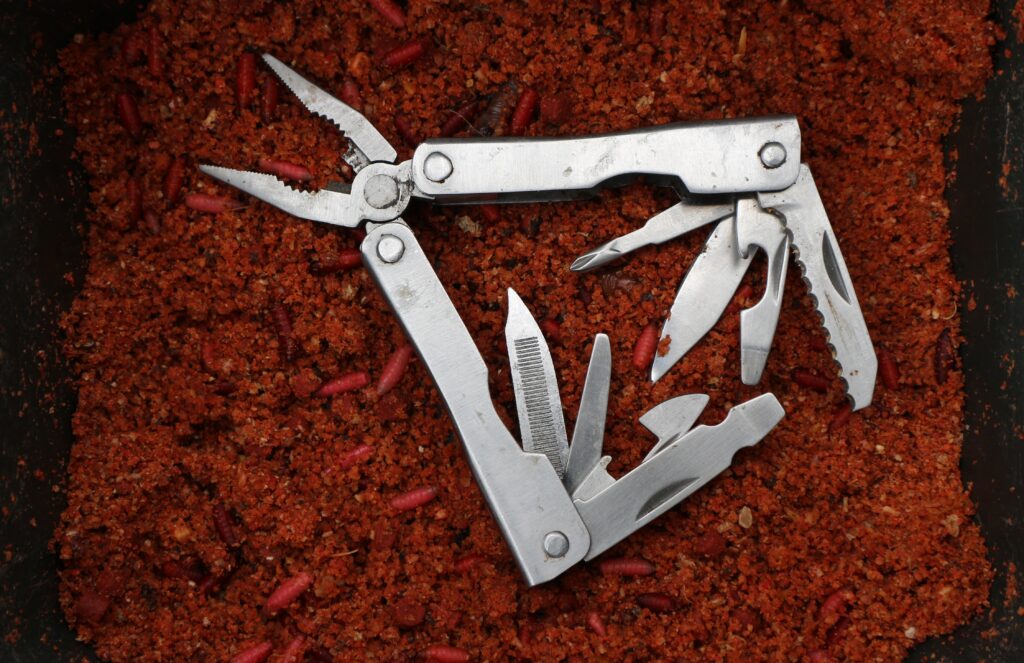
I have lost count of the times this compact stainless-steel multi tool has got me out of fixes when I’ve been out on the bank fishing. I know most tins of bait have ring pulls these days, but the can opener on my multi tool has come into play several times when the often-fragile finger grips on lids have snapped off. The various screwdrivers have helped fix reel problems and swivel top rod rests that have worked loose. The pincers are mainly employed for firmly applying larger sizes of split shot to line, but have also released rusted-up thumb screws on metalware. The penknives are great for dicing up bait. There’s a file too, while the saw blade got me out of trouble when I needed to telescope a broken pole section back together, also being handy for removing branches that are in the way. There’s a bottle opener if I want a beer while working on tackle at home, so I don’t think there’s anything I haven’t used on this brilliant little gadget.
BREAD PUNCHES
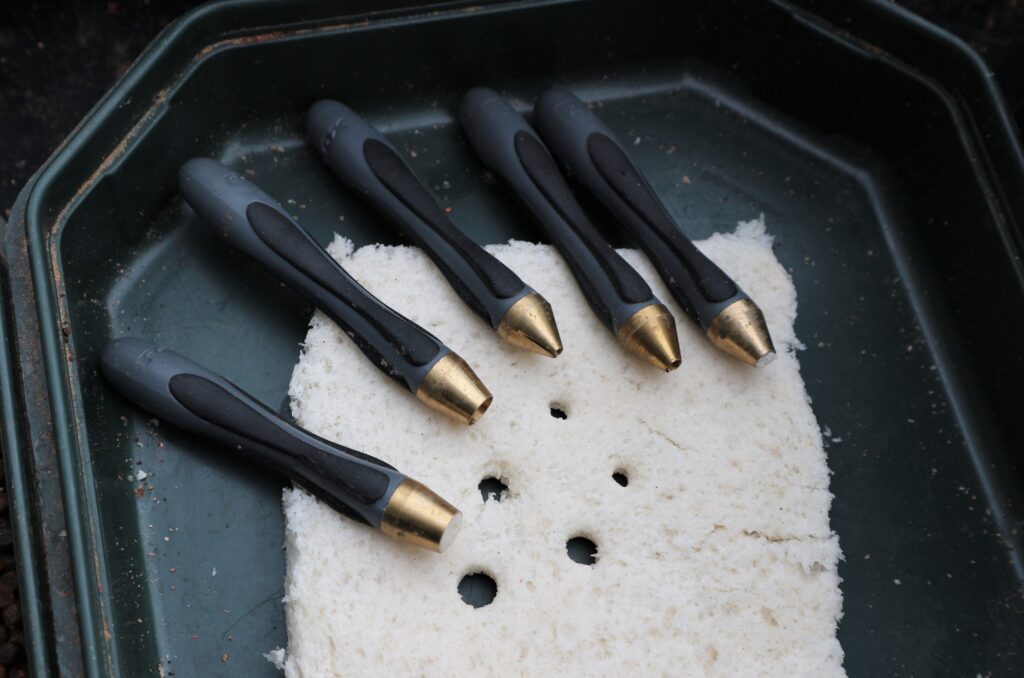
I own several sets of bread punches, which are useful little tools for compressing and cutting out small discs of fresh white bread for the hook. They don’t see as much use as they did in the past, because things have changed since pellets have become such an important part of fishing. Punched bread first captured my interest when I began match fishing the London canals. There were some top experts at this type of fishing, seemingly bagging up from any swim they drew with the method. After much practise, I realised bread could make things happen in otherwise poor areas. It had the ability to conjure bites out of nothing. It once gained me runners-up spot on a 300-peg canal match, with a cracking net of quality roach, unusually taken on the waggler. It was only a far away shoal of carp that beat me. There were some stretches of canal where I would fancy my chances of framing from any peg. This simple, cheap bait used to be that effective.
MEAT PUNCHES
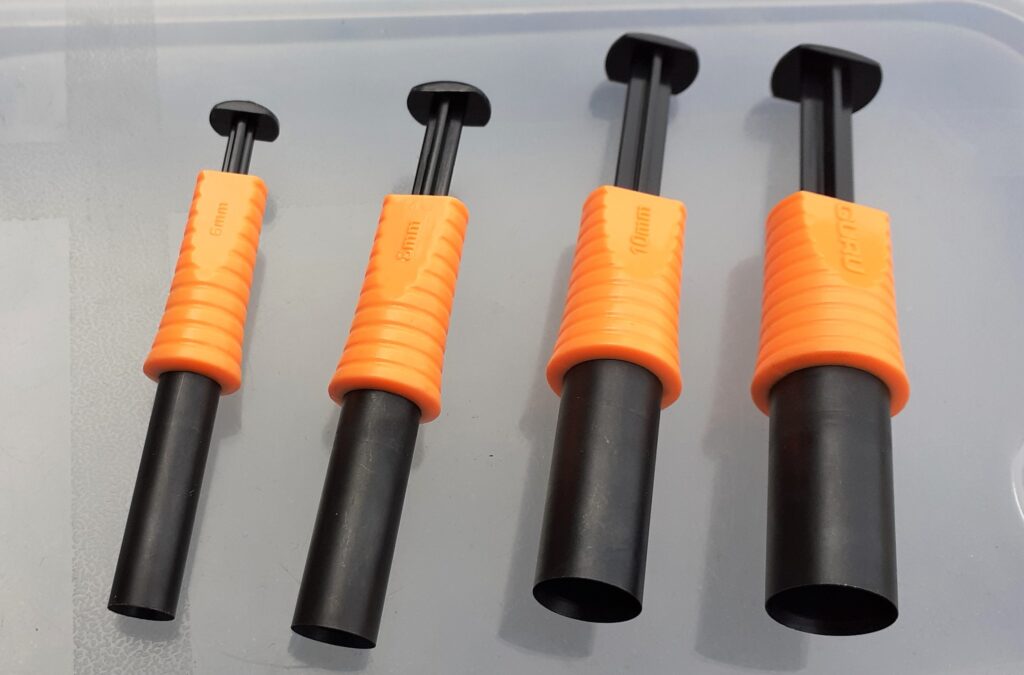
These days meat punches probably outsell bread punches by a country mile. These Guru ones have become very popular for cutting out soft luncheon meat, aimed at carp and other big fish. They are neatly designed and compact, coming as a separate set, or as part of a boxed-up system. Sizes are 6mm, 8mm, 10mm and 12mm, which can also be used on slices of bread when bigger offerings are required. But it’s pellet-shaped discs of meat that are most used, often in combination with pellet feed. The idea behind the box concept originates from the famous Image bread punch version, which had a sliding lid and helped to keep a slice of bread fresh. The Guru box is much bigger but still designed to keep various baits in tiptop condition, featuring a tinted lid to avoid them getting roasted in hot weather. A hard base gives a working surface, so hook baits can be compressed or cut out inside. The plunger-style handles always eject baits effectively.
DISGORGERS
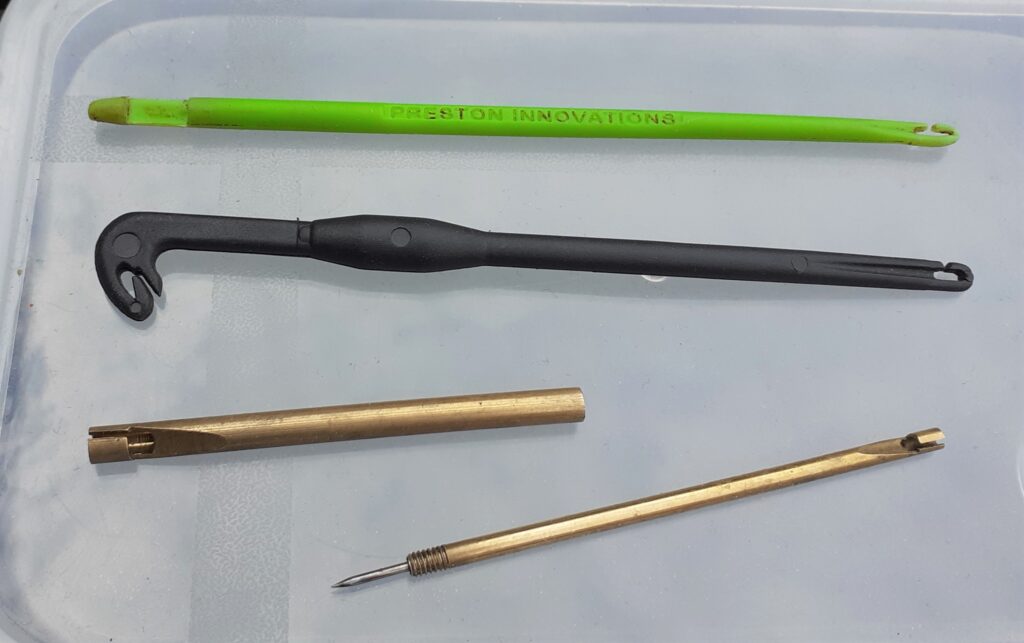
I use several types of disgorgers. The Preston one at the top of the photograph is good because it has a standard slotted head at one end, along with a Slammo-style loop at the other. In the latter case line is trapped inside the loop to avoid coming adrift. This is the kindest tool to use when species like skimmers and perch swallow baited hooks completely. Unlike with normal disgorgers, mono rarely comes adrift, while as the loop hits the bend of the hook it normally dislodges it. Slotted head disgorgers work best when the hook is visible. The black product in the middle features a Slammo-style hook remover too, combined with a useful loop tyer at its other end, handy for forming small attachment loops on hook lengths. The metal disgorger underneath offers medium and small slotted heads and works better than I first imagined it would. A stainless-steel knot picker is revealed when it’s unscrewed, which has come in very handy.
QUICK NEEDLES
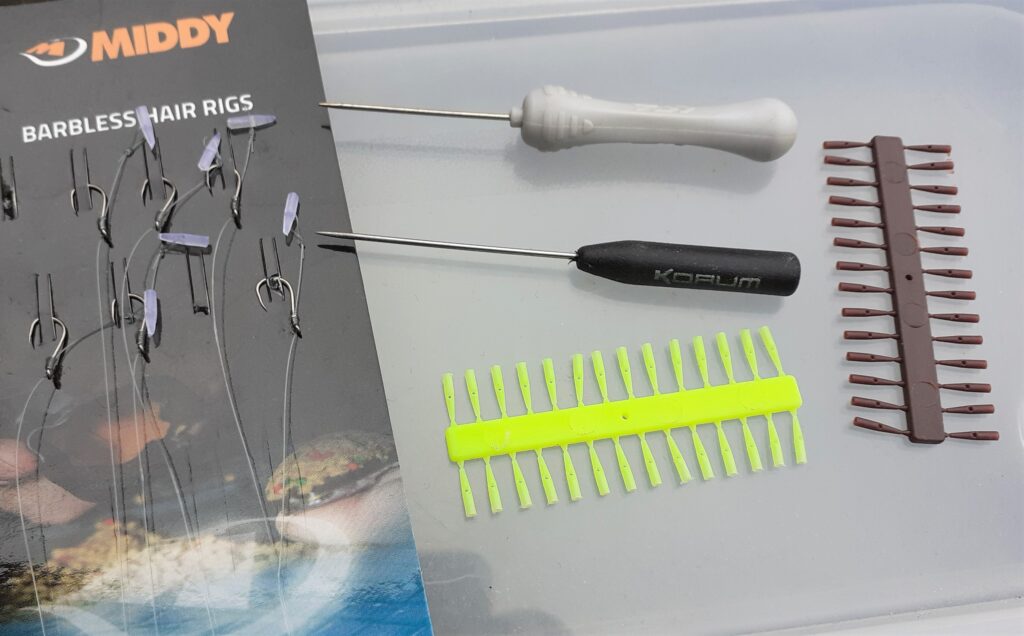
Quick Stops initially came from Korum. These are tiny hollow pointed bait stops that are designed to be tied to hairs. But in order to thread these plastic stops through soft or drilled baits you need a small needle. I still have one of the originals, which I find doubles up perfectly as a knot picker. It’s only a small tool, but I like to have one close to hand, because it’s great at unpicking wind knots in mono or braid, also for sorting out terminal tackle tangles. In the latter case I always think it’s worth trying to save a rig that’s working well. It’s often quicker to untangle than to make up another, which is never guaranteed to be as effective. Other companies have jumped on the bandwagon with similar speed stops and matching needles to operate them with. It’s handy that you can now get different colours and sizes, to match up with the baits you are using. This concept has become popular with match anglers because, as the name suggests, it’s fast to use.
CHOP SCISSORS
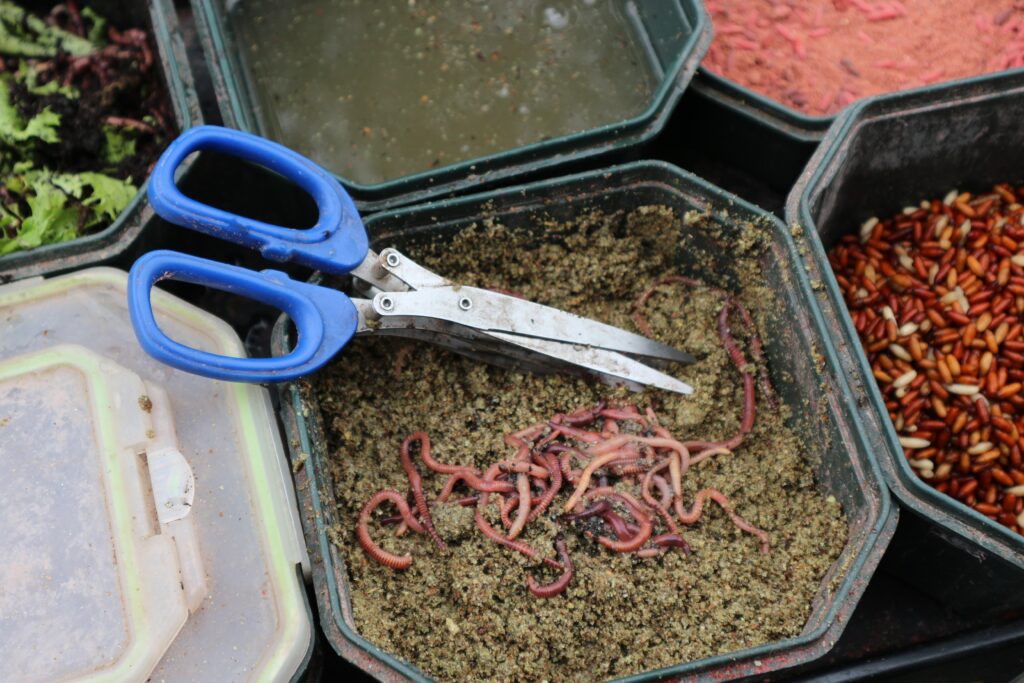
Although not strictly a tackle box tool, these triple blade chop scissors see lots of use. I store them in an end pocket in my carryall, for chopping up quantities of worms, but also sometimes other baits like soft pellets and meat. Mulching the latter and then cupping them in, or adding to groundbait, keeps fish interested for long periods. Notice my chop scissors are longer than most. I find the extra reach handy when preparing baits inside fairly deep pole cups. As with rig scissors, I prefer elongated handles, which provide a more substantial grip. I use chopped worm regularly to kick-start swims, so these scissors are normally kept on my bait table. Three blades are about right I think. I did try a four-bladed model, but it was on the heavy side and awkward to use. I’ve seen anglers using standard single-blade scissors for this task, but that’s too long-winded for me. Some even tape cheap scissors together for chopping purposes, in the quest to save a few bob.
CLIPPERS
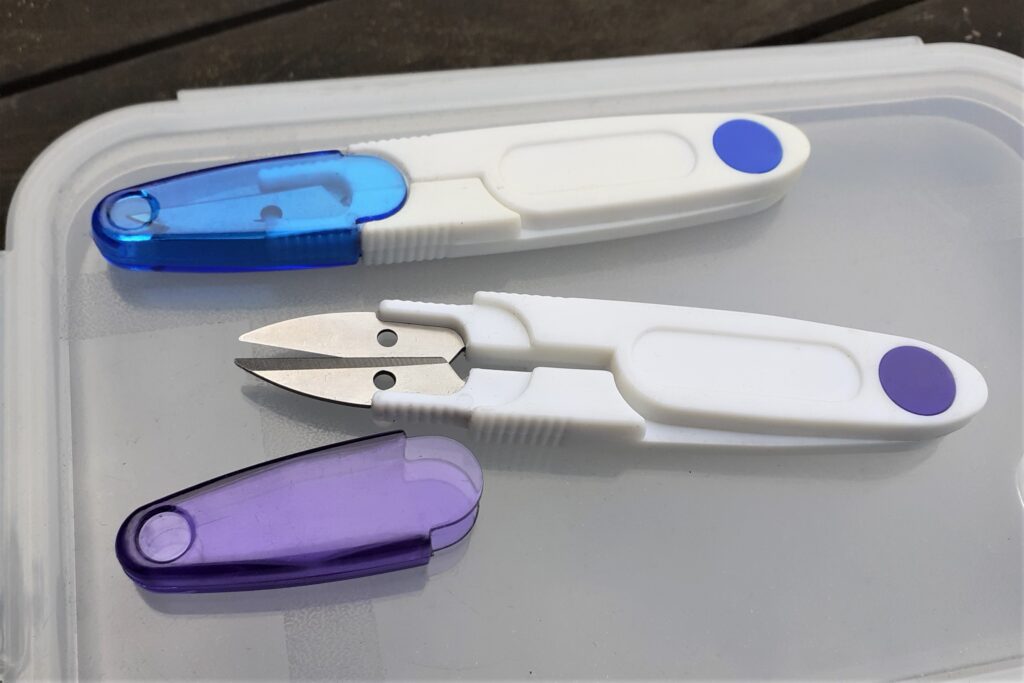
Line clippers are quite compact, neatly finding a place in even small tackle boxes, which is probably why they are popular. In similar fashion to rig scissors, clippers or snippers are great for trimming knots in braid or nylon, also for paring down hook baits, even for chopping up a few worms. Some anglers prefer this type of cutter over normal scissors because it has a protective cap, which makes it much safer to carry in a pocket. In effect it locks the tool, something you can’t do with scissors, apart from rare models that come with a sheath that protects their blades – and your fingers if you carry them in a pocket. I’ve tried using clippers or snippers, but never really got on with them. I would probably be a fan if I was into travelling light and the roving approach, but my favourite compact rig scissors have a special place in one of my seat box drawers, where I can locate them without even looking. I do own clippers, but only as emergency back-up.
MOULDS
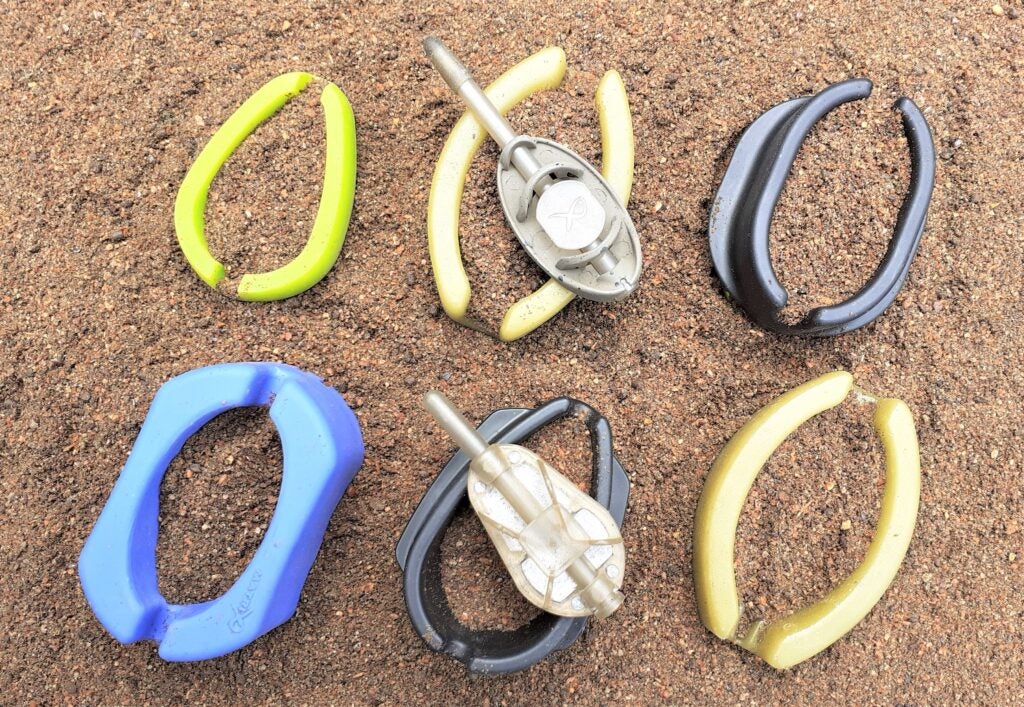
Method feeder moulds are really tools if you think about it. The definition of a tool is an implement used to carry out a particular function. Moulds certainly do that, making flatbed method feeder fishing so much easier. I only tend to use flatbeds anyway, liking the way a matching mould does all the hard work for you, forming perfectly streamlined loadings of groundbait or pellets every time. Moulds also give you choices of burying hook baits or presenting them on top of whatever you are feeding. I mainly use these options because if you leave short hook lengths free on the cast, they can tangle back around the feeder. One thing I have noticed with the various method moulds in my collection, is the shiny surface ones are less likely to get groundbait or micro pellets sticking to them. Due to this problem, some anglers use a small plastic bag over their moulds, which helps to eliminate the issue. Spring-loaded moulds are very good too.
The post Tackle Box Tools first appeared on FishingMagic Magazine.
Continue reading...

Certain tools make life easier while fishing, even to the extent of improving your results. A decent pair of rig scissors being a good example. With hook knots in particular, I suspect fish can feel long tag ends when they are mouthing baits, which is likely to make them suspicious and potentially reject them. A simple pair of stainless-steel rig scissors, with pointed blades, saves your teeth and trims knots more precisely. Finely tapered tips trim neater than round-nosed ones, which are harder to butt up close to knots. Scissors suitable for storing in a tackle box are best if they are on the compact side, making sure they have slightly elongated handles. I avoid small scissors with round grips, which don’t tend to suit angler’s fingers very well. It’s also good to have handles covered with non-slip rubber grips, making delicate operations with wet hands go more smoothly. Apart from trimming line, I use rig scissors for snipping various hook baits.
STYL PINCERS

I’ve had these pincers in my fishing kit for several decades. I still see similar designs in tackle shops to this day. I originally used them with Continental Styl weights, but they are now employed for applying the shorter Preston Stotz version to line. Stotz replicate micro shot sizes from 8s to 13s, but instead of being round are elongated, making them easier to nip onto fine lines. Due to this, I hardly ever use small round shot anymore. I know there’s a special tool for Stotz weights, but I find it too blunt-nosed and awkward to operate. Styl pincers have much finer jaws, allowing tiny weights to be picked up from a flat surface in a speedier manner. They have a better feel factor too, so I can gauge just the right amount of pressure to apply. I also use them to flatten barbs on small hooks, a job they do perfectly. I still have a Stotz tool, called a Stotta, using its special cutting tooth to remove excess weights from mono, a task it is very good at performing.
NEEDLE & DRILL

When I used to work in a big tackle shop I got fed up with trying to find matching hair needles and drills, which customers were always asking for. Lots of companies produced these products, but it was never easy to get the right match. Typically, I think it was Drennan who brought out the first proper combo, so you knew the needle would go through holes in any hard baits that the slightly bigger drill had made. When I was product development manager for Greys, I took this a step further, designing a hair needle and drill set that clamped together, a bit like a pen, along with a protective cap. Because tools like these are on the small side, it can be tricky to get enough grip to drill hard items, so the idea was to push the two units together for jobs like that. I made the handles square, so they wouldn’t roll off tackle box lids, or bait trays and tables. I always had an agenda of striving to produce tackle accessories that made a difference.
PELLET BANDER

Every now and then something comes along that makes a big change to the way we fish. I suspect pellet bander tools might have originally been designed for a different usage, but fair play to whoever discovered them and applied the concept to banding pellets. These tools make life so much easier when using tiny latex bait bands, especially the type ready-installed in looped hairs. Even mini sizes can quickly be stretched over hard pellets up to 8mm, along with small buoyant wafters, only taking a few seconds to do the job. This results in nicely presented hard baits, much faster than fussing about with drills, needles and fiddly bait stops. Pellet banders have inspired anglers into experimenting, to the extent some now even band natural baits like maggots and casters in the quest for superior presentation. A few of my mates are dextrous enough with their fingers to get by without these tools, but I often sneakily use them to keep up.
MULTI TOOL

I have lost count of the times this compact stainless-steel multi tool has got me out of fixes when I’ve been out on the bank fishing. I know most tins of bait have ring pulls these days, but the can opener on my multi tool has come into play several times when the often-fragile finger grips on lids have snapped off. The various screwdrivers have helped fix reel problems and swivel top rod rests that have worked loose. The pincers are mainly employed for firmly applying larger sizes of split shot to line, but have also released rusted-up thumb screws on metalware. The penknives are great for dicing up bait. There’s a file too, while the saw blade got me out of trouble when I needed to telescope a broken pole section back together, also being handy for removing branches that are in the way. There’s a bottle opener if I want a beer while working on tackle at home, so I don’t think there’s anything I haven’t used on this brilliant little gadget.
BREAD PUNCHES

I own several sets of bread punches, which are useful little tools for compressing and cutting out small discs of fresh white bread for the hook. They don’t see as much use as they did in the past, because things have changed since pellets have become such an important part of fishing. Punched bread first captured my interest when I began match fishing the London canals. There were some top experts at this type of fishing, seemingly bagging up from any swim they drew with the method. After much practise, I realised bread could make things happen in otherwise poor areas. It had the ability to conjure bites out of nothing. It once gained me runners-up spot on a 300-peg canal match, with a cracking net of quality roach, unusually taken on the waggler. It was only a far away shoal of carp that beat me. There were some stretches of canal where I would fancy my chances of framing from any peg. This simple, cheap bait used to be that effective.
MEAT PUNCHES

These days meat punches probably outsell bread punches by a country mile. These Guru ones have become very popular for cutting out soft luncheon meat, aimed at carp and other big fish. They are neatly designed and compact, coming as a separate set, or as part of a boxed-up system. Sizes are 6mm, 8mm, 10mm and 12mm, which can also be used on slices of bread when bigger offerings are required. But it’s pellet-shaped discs of meat that are most used, often in combination with pellet feed. The idea behind the box concept originates from the famous Image bread punch version, which had a sliding lid and helped to keep a slice of bread fresh. The Guru box is much bigger but still designed to keep various baits in tiptop condition, featuring a tinted lid to avoid them getting roasted in hot weather. A hard base gives a working surface, so hook baits can be compressed or cut out inside. The plunger-style handles always eject baits effectively.
DISGORGERS

I use several types of disgorgers. The Preston one at the top of the photograph is good because it has a standard slotted head at one end, along with a Slammo-style loop at the other. In the latter case line is trapped inside the loop to avoid coming adrift. This is the kindest tool to use when species like skimmers and perch swallow baited hooks completely. Unlike with normal disgorgers, mono rarely comes adrift, while as the loop hits the bend of the hook it normally dislodges it. Slotted head disgorgers work best when the hook is visible. The black product in the middle features a Slammo-style hook remover too, combined with a useful loop tyer at its other end, handy for forming small attachment loops on hook lengths. The metal disgorger underneath offers medium and small slotted heads and works better than I first imagined it would. A stainless-steel knot picker is revealed when it’s unscrewed, which has come in very handy.
QUICK NEEDLES

Quick Stops initially came from Korum. These are tiny hollow pointed bait stops that are designed to be tied to hairs. But in order to thread these plastic stops through soft or drilled baits you need a small needle. I still have one of the originals, which I find doubles up perfectly as a knot picker. It’s only a small tool, but I like to have one close to hand, because it’s great at unpicking wind knots in mono or braid, also for sorting out terminal tackle tangles. In the latter case I always think it’s worth trying to save a rig that’s working well. It’s often quicker to untangle than to make up another, which is never guaranteed to be as effective. Other companies have jumped on the bandwagon with similar speed stops and matching needles to operate them with. It’s handy that you can now get different colours and sizes, to match up with the baits you are using. This concept has become popular with match anglers because, as the name suggests, it’s fast to use.
CHOP SCISSORS

Although not strictly a tackle box tool, these triple blade chop scissors see lots of use. I store them in an end pocket in my carryall, for chopping up quantities of worms, but also sometimes other baits like soft pellets and meat. Mulching the latter and then cupping them in, or adding to groundbait, keeps fish interested for long periods. Notice my chop scissors are longer than most. I find the extra reach handy when preparing baits inside fairly deep pole cups. As with rig scissors, I prefer elongated handles, which provide a more substantial grip. I use chopped worm regularly to kick-start swims, so these scissors are normally kept on my bait table. Three blades are about right I think. I did try a four-bladed model, but it was on the heavy side and awkward to use. I’ve seen anglers using standard single-blade scissors for this task, but that’s too long-winded for me. Some even tape cheap scissors together for chopping purposes, in the quest to save a few bob.
CLIPPERS

Line clippers are quite compact, neatly finding a place in even small tackle boxes, which is probably why they are popular. In similar fashion to rig scissors, clippers or snippers are great for trimming knots in braid or nylon, also for paring down hook baits, even for chopping up a few worms. Some anglers prefer this type of cutter over normal scissors because it has a protective cap, which makes it much safer to carry in a pocket. In effect it locks the tool, something you can’t do with scissors, apart from rare models that come with a sheath that protects their blades – and your fingers if you carry them in a pocket. I’ve tried using clippers or snippers, but never really got on with them. I would probably be a fan if I was into travelling light and the roving approach, but my favourite compact rig scissors have a special place in one of my seat box drawers, where I can locate them without even looking. I do own clippers, but only as emergency back-up.
MOULDS

Method feeder moulds are really tools if you think about it. The definition of a tool is an implement used to carry out a particular function. Moulds certainly do that, making flatbed method feeder fishing so much easier. I only tend to use flatbeds anyway, liking the way a matching mould does all the hard work for you, forming perfectly streamlined loadings of groundbait or pellets every time. Moulds also give you choices of burying hook baits or presenting them on top of whatever you are feeding. I mainly use these options because if you leave short hook lengths free on the cast, they can tangle back around the feeder. One thing I have noticed with the various method moulds in my collection, is the shiny surface ones are less likely to get groundbait or micro pellets sticking to them. Due to this problem, some anglers use a small plastic bag over their moulds, which helps to eliminate the issue. Spring-loaded moulds are very good too.
The post Tackle Box Tools first appeared on FishingMagic Magazine.
Continue reading...
